Many allotment sites do not have the benefit of mains water. Rainwater harvesting and storage is the solution adopted by Elizabeth Way Allotments, Coventry. Many thanks to them for sending the information and photographs.
As their allotments never had access to running water, they decided to improve the situation and construct their first water station. The water station is additional to plot holders own water collection systems, used for emergency and dry spells though the summer months.
Even sites and gardeners with access to mains water would be well to consider installing an independent supply system. Whenever we get a hot, dry summer and need to water it seems a hosepipe ban is implemented. These bans only apply to mains water not that from your own storage.
They say:
Firstly, we would like to thank the Coventry City Council & CDA&G for their help and support with this project. The construction as you can see is wonderful for the environment, completely stand alone, can be constructed in any spare area on any allotment or perhaps smallholding.
The water harvesting station provides a cost effective and a wonderful addition to any allotment. This design is easy to erect, with a cost ranging from £500.00 to £1000.00 and can be erected by members with general handyman experience.Once constructed it comes with little maintenance and gives many years of free water.
Firstly they decided to install two strip concrete footings as their ground is unstable at certain times of the year. Next they constructed a timber frame to support the Perspex sheeting. This sloped down to a standard gutter system to supply the storage tanks below. The posts are seated in standard Drive-in Post Anchors.
Important
I can see a potential problem with the design in high winds where the force would be upwards on the sheeting. It’s important that the sheets are properly fixed to the frame.
Storage
Storage is in four IBC containers. These standard sized – one metre cubed – containers are readily available second hand on Ebay at around £50.00. Look for “FOOD GRADE” containers to avoid any poison’s that were previously stored in the tanks possibly affecting the produce grown
Each container is able to hold 1,000 litres giving 4,000 litres when all four containers are full.
Placing the containers
The IBC containers need to be lifted from the ground to enable easy filling of watering cans etc. This is accomplished by mounting the containers on concrete blocks, three high. Use the high density blocks because they will have to carry a lot of weight. The builder’s merchant will point you to the right product. 1,000 litres of water weighs 1,000 kilograms plus the container weight.
It’s critical that the support is sturdy and stable as a collapse is potentially dangerous. Ensure the blocks are placed on a firm base. Do not use pallets to support the tanks. Over time the pallets will rot and collapse.
Filling Watering Cans
Hose union bib taps have been fitted to each unit, and each container has been fitted with small section of garden hose with the use of jubilee clip to cut down on the waste of water when in use. Each container is connected by the use of standard plastic waste pipe and fitting, all available from local plumbing merchants.
Keeping the water sweet
As rainwater enters the first container make sure that the hole put in top of tank to receive the water is a tight fit and sealed to avoid mosquito’s & larvae at a later date, always keep the top inspection lid in place to help avoid this problem.
It may be advisable to obtain black covers for the tanks to help with discolouration in water over time if funds allow. There are a number of inexpensive commercial products available to keep the water clear of insects, algae and bacteria such as legionella. See Keeping Water Clean & Safe

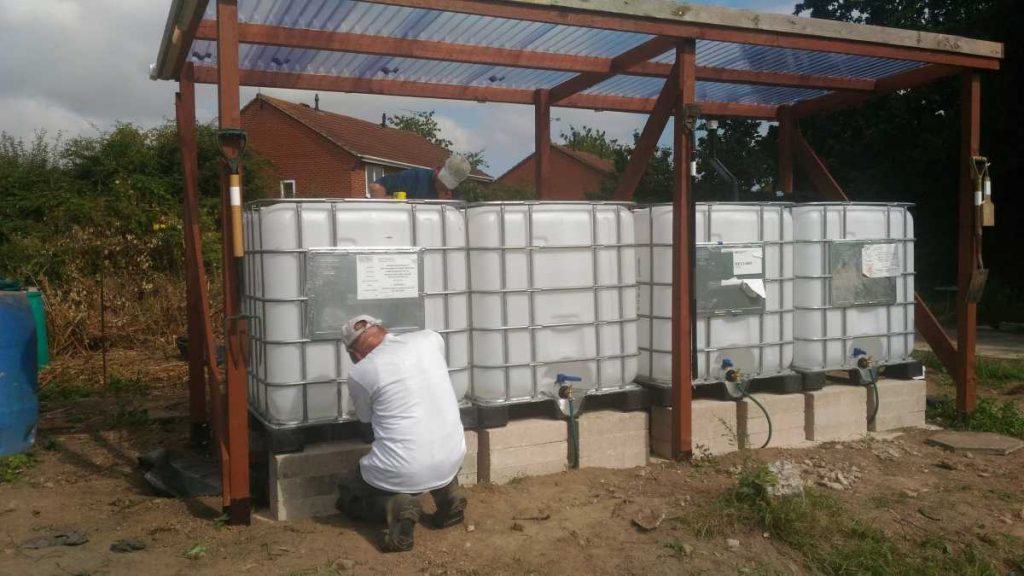
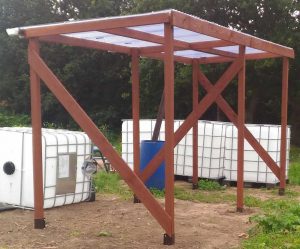
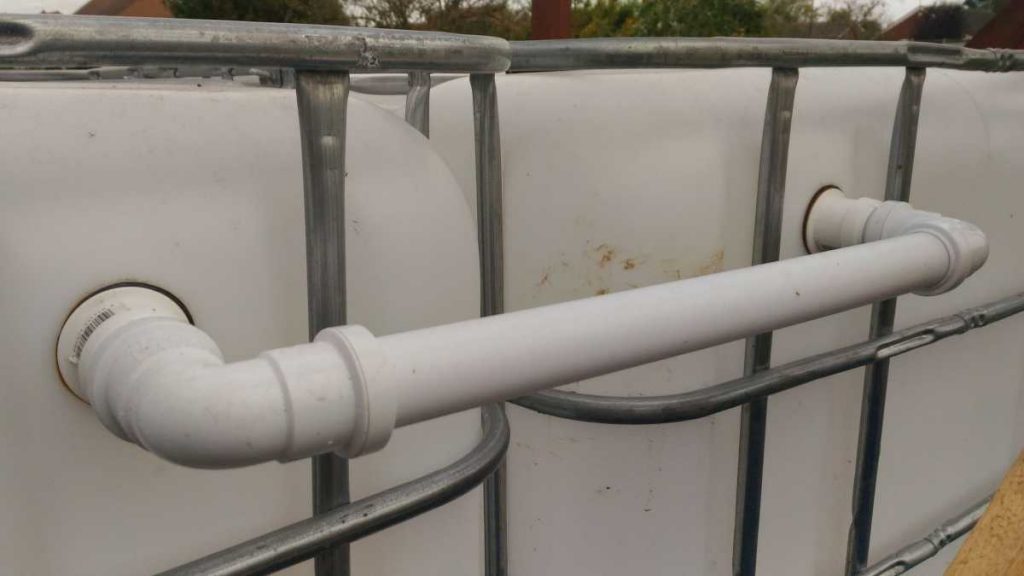
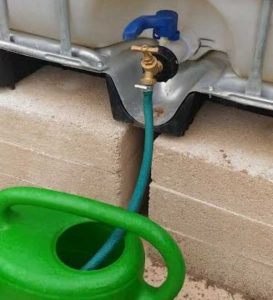
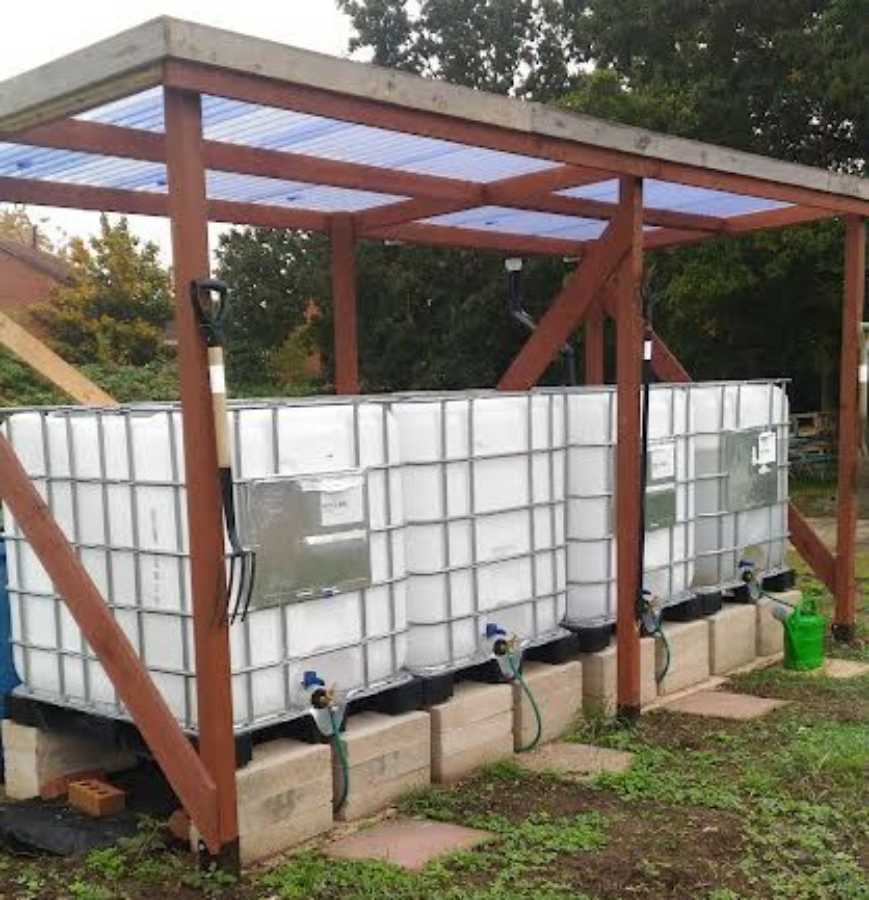



We have done a similar project with 4 off IBC’s. They work really well, taking the supply from nearby roofs we can fill one IBC with about two days rain fall. We did not run out of water once this year. We were advised to screen the IBC’s to prevent the sunlight from turning the water green, this we did with a green tarpaulin. We also filtered the water with a 25mm mesh, then a 5mm before water entered the IBC’s this keeps the water much cleaner. We’ve kept our IBC’s separate and not linked them at the moment, but we have been offered four more IBC’s which we will use as header tanks and link them. We bought our first IBC’s on-line for as little as £25 each, but now we have found an even better supplier! (Free). I would be happy to circulate pictures of what we have done, if anyone is interested. Robert
Hi Robert
If you want to email photos across to me I will happily pop them on the site. Or, if you’re registered on the forums you can post images easily and directly.
I am steward of a site in Bristol and looking to build similar this summer, do you have any pics, plans, spec etc would be really useful
Yes any pictures and/or plans appreciated
Robert, I am a committee for a new allotment in Warwick, Warwickshire, and we have been inspired by your water harvesting structure to attempt our own. Do you have a plans or similar you could share? Kind regards, Simon.
A great idea and looks to be quite scaleable, too.
Does that trigger the requirement for planning permission by having foundations?
This document suggests it might.
http://www.wlcvs.org/wp-content/uploads/2015/04/CFG_-_Planning_Digging_Below_the_Surface_Final_2.pdf
I really can’t see the planning authorities taking much notice of something like this. If it was a concern then laying thick slabs on the soil to spread the load would avoid that, I think.
Concerns about climate change and because our allotment site relies on groundwater, we decided a couple of years ago to publish a short report for members on the future of our supply. It might interest others.
https://www.paddocks-allotments.org.uk/perch/resources/water-at-the-rpa-proofed-and-changes-accepted.pdf
Thanks for sharing that, Ray. A well produced and interesting report laying out the options clearly.
Hi Ray,
How’s it going?
I haven’t found a new allotment but am involved with a local community garden!
I miss RPA life.
Kate
My Chicken Aviary has a 10 sq mt Galvanised corrugated roof that all goes into a 30 gal water Butt
I also have 3 additional 30 Gal Butts and 2 x 22 Gal Butts off sheds and greenhouses + 2 others approx 40 gals together that are filled from chicken roof supply via a battery drill powered pump used for hand washing etc
All materials were Salvaged or given I have bought 1 new 30 Gallon Butt only
And all around me I see roofs with no means of collection or storage
Hi Robert.
THAT is the way to go.
I have 2 allotments in very different areas and rules.
YOU are doing what we All should be doing.
Butt(pun) they all take up space.
The committee/council etc. Should Now be going into this A.S.A.P if not quicker.
GOOD on YOU
Great ideas. The webinar on this at the National Allotments Association was very good. I have been saving yoghurt cartons etc to put in 5 trays. Have filled a tank sofar this autumn.
It’s also a smart move to capture water because there’s no running up and down to the water supply. A cheapo eastern solar panel(with controller) a couple of knackered batteries (you don’t need to start a car with them anymore) an eastern 12v water pump (5litres a minute is cheap and it’s where I started) and you have a hose pipe system. Run some lengths down your plot, tee in with a cheap isolation tap and you have multi water points for your short hose. incorporate a wifi relay for the pump and you wont even have to go back to the pump to turn it off to change where you’re taking water from!
With that setup and 2k litres available I didn’t run out of water (down to 200-ish litres) during the 3 weeks of hot weather even with soaker hoses in my beans and squashes trenches which were turned on for 5 minutes a day.
The containers are in the shade, they are fed by my 6×8 shed and a 4ft square cover, there’s a debris mesh on the way in and a micro mesh filter on the way out to protect the pump and sprayer. (they are tee’d into each other so it takes from both at the same time)
It may seam a bit over the top for an allotment but it is more than achievable by anyone and generally makes things easier all round when you can give your crops the amount of water they need without all that walking up and down to the water tubs. plus there is power available to charge your phone (all controllers have a usb port) and also provide outside light and security.
Heck Derek.
Ok I’m Female. Not blonde.
I read what you say. Would like to do what you say.
But, having a very much (sorry) female moment.
am I on MSN where I could be CANCELLED as I spoke of gender?
Sometimes it is just –so nice– to have some help.
Contacts/nearby. Helping hand or just face to face conversation?
Hey Jane,
I’m on a council plot so there is no co-ordination from the authorities ya just pays your fiver for a water tap key and you gets on with it!
Well I do anyway.
I’ve upped my storage to 4k litres now and intend to increase by another 2k by this winter.
I manage to fill all my IBC’s during storm Arwhen and insulated and covered them for the winter with no incident.
Already this year I’ve used 2k litres on my plot (amazing onions) and the storm last Sunday gave me back 750 litres thankfully.
I’m very happy to help with schematics etc. but don’t know how to message direct from here or if I’m allowed to post email even
In process of building an IBC Water Harvesting System
-I have one lucky break, at the back of my plot a very slow running stream. I’m looking at building a little catchment area within it and Reed Planting next spring It will have be done slowly so I don’t break any planning issues. Last Winter there was major flooding – and then may be a different case. So looking into solar panel to draw off as tedy amount – Will post more when completed. If I could only lay my hands on FREE IBCs
Great ideas!
I found that a ‘free’ filter could be made from taking any scraps of hard plastic debris netting which had been left over from the beds, literally rolling them into a small ball, and plugging them into the down pipes!
You could make several ‘filters’ in the pipes on the way down to the IBC, and it takes just a minute to hoik them out after the winter, when any caught-up debris has rotted.
Because the mesh is quite cellular but robust, there is no danger of these filters actually blocking the pipes.
We have been doing this for years. We do not have mains water so our wells cold go dry in a long dry summer, the watertable gets low anyway by the end of august so we got black food grade IBC tanks and placed them in areas above the orchard, garden, animal sheds and house so we could gravity feet to wherever we want. We fill them when there is a surplus of water in about March/April. It has worked very well for us. I understood Black was food grade and transparent /white is not. This is a super idea for allotments.
I build a roof over my 3 bay compost station and put guttering leading to the first barrel with 6 other barrels linked. It rained heavily this year and so I have 7 full barrels and have not really had to use any of it over the summer, except for the poly tunnel. I am sure it will come into its own over the next years, as we have no water on the plot and I was dragging water I have to pay for from home. Really happy to have the system in place and I would encourage all to do likewise.
I took on an overgrown allotment Sep 2019. Boy am I pleased – what a life saver for me during the pandemic of 2020. However, I soon learnt that even though there is a top on the allotment, one tap for 25 allotments is not enough. Secondly this tap is a spur of the main tap in the adjacent block of allotments resulting in no water whilst they are using water.
So during the autumn/winter of 2020, I built my own shed and covered area to collect water into 4 blue barrels. Through a bit of watching YouTube videos, I worked out how to connect these barrels together without taking the tops of using 2 inch connectors available from amazon. In March 2021, I extended the covered area – its now about 8m long x 1.5m wide and collects into two banks of 4 blue barrels giving me a total of 2000 l. I am planning to connect another 4 barrels when I can source them (These all come of farms in Wiltshire free, but I need to get them to Norfolk – the pandemic has stopped this.)
In April 2021, after spending so much time watering onions due to the long dry period in 2020, I set up an automatic watering system which I will extend next year. This consisted of two hoses connected to each bank of barrels, fed to a Hozelock auto irrigation timer. From the timer two houses feed each end of a series of soaker hoses. The timer turned the water on at sun set and sun rise for a set period (10min) of time every 2 or days depending what I set it on. I had soaker hoses on my runner and french beans and simply turned on this hose when I was down the allotment for a period of time and ensured it was turned off before I went home.
As a result of all of this, I hardly had to water by hand this summer gone. The 8 barrels provided sufficient water for my allotment (35m x 8m). I would recommend that every one with an allotment should collect their own water.
Since May 2020, I have bought no vegetables other than 2 x 1.5kg of potatoes (as my potatoes did not keep long enough), tomatoes, peppers, ginger (I have no greenhouse or polytunnel) and mushrooms.
If you are interested, I have photos of my water collection system and my soaker hose watering system and also some cages I built to prevent carrot fly, cabbage root fly and cabbage caterpillars from attacking my crops.
Hi Glyn, I’d be interested in seeing photos of your carrot and cabbage cages? Cheers for now, Jasmin.
We have had similar arrangements for several years – 7 IBCs fed from the site shed roof supplemented about 2 years ago by 3 fed from an almost identical structure to the one illustrated, except that our IBCs are beside the catchment structure. It has a bench under it, so that members can take shelter while the tanks are being topped up. It is referred to as ‘the bus shelter’ but, as yet, no buses have stopped there. The system is most beneficial in a year with a good mix of weather. In a long dry spell it is not long before they are empty. (Eden Drive Allotments, Oxford)
Hi John, that is a useful article.
Do you have any thoughts about linking an IBC or any other storage to a soaker hose? Is gravity sufficient to distribute water around a flat site?
Hi Ian
I think soaker hoses will work at low pressures but it depends on the head. There’s a few battery powered pumps that could be the solution. Bosch and Karcher certainly do battery pumps.
Could be a problem on an allotment site if £80+ worth of kit vanishes.
Hey John,
You need inline pumps not submersibles, then have the pumps and connections inside a building. slap a camera on the door (inside looking out through a hole) and with a red glowing LED on show (really bright at night) would be scum seem to be put off and couldn’t do much damage anyway unless they wanted to cut pipes out of spite! I had someone turn my taps on down the plot but it did no harm as the pump wasn’t running.
At what point would a structure like this (in the OP) require planning permission? We want to accommodate around 20 IBC’s on our site but are delaying for fear of upsetting the authorities.
First of all, I don’t think it would require planning permission but your council planning officer should be able to advise.
You say ‘authorities’ – best thing to do is ask them and address any objections they may have to what is obviously a green project.